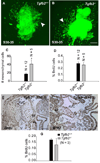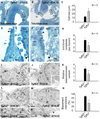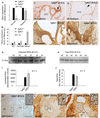Ligand-specific function of transforming growth factor beta in epithelial-mesenchymal transition in heart development
- PMID: 19161227
- PMCID: PMC2805850
- DOI: 10.1002/dvdy.21854
Ligand-specific function of transforming growth factor beta in epithelial-mesenchymal transition in heart development
Abstract
The ligand specificity of transforming growth factor beta (TGFbeta) in vivo in mouse cardiac cushion epithelial-to-mesenchymal transition (EMT) is poorly understood. To elucidate the function of TGFbeta in cushion EMT, we analyzed Tgfb1(-/-), Tgfb2(-/-), and Tgfb3(-/-) mice between embryonic day (E) 9.5 and E14.5 using both in vitro and in vivo approaches. Atrioventricular (AV) canal collagen gel assays at E9.5 indicated normal EMT in both Tgfb1(-/-) and Tgfb3(-/-) mice. However, analysis of Tgfb2(-/-) AV explants at E9.5 and E10.5 indicated that EMT, but not cushion cell proliferation, was initially delayed but later remained persistent. This was concordant with the observation that Tgfb2(-/-) embryos, and not Tgfb1(-/-) or Tgfb3(-/-) embryos, develop enlarged cushions at E14.5 with elevated levels of well-validated indicators of EMT. Collectively, these data indicate that TGFbeta2, and not TGFbeta1 or TGFbeta3, mediates cardiac cushion EMT by promoting both the initiation and cessation of EMT.
Figures





References
-
- Abdelwahid E, Pelliniemi LJ, Jokinen E. Cell death and differentiation in the development of the endocardial cushion of the embryonic heart. Microsc Res Tech. 2002;58:395–403. - PubMed
-
- Barnett JV, Desgrosellier JS. Early events in valvulogenesis: a signaling perspective. Birth Defects Res C Embryo Today. 2003;69:58–72. - PubMed
Publication types
MeSH terms
Substances
Grants and funding
LinkOut - more resources
Full Text Sources
Other Literature Sources
Molecular Biology Databases
Miscellaneous

